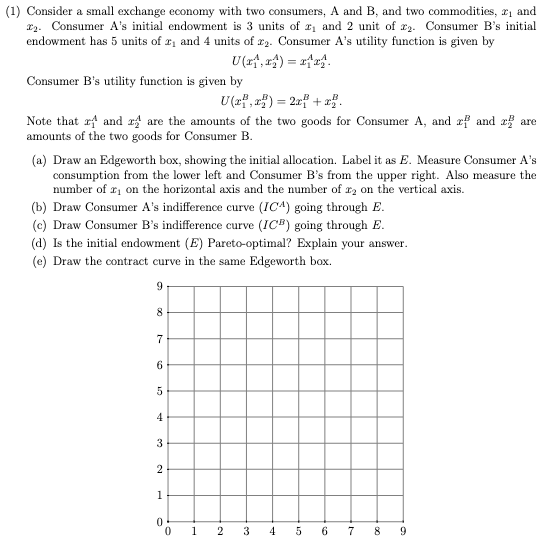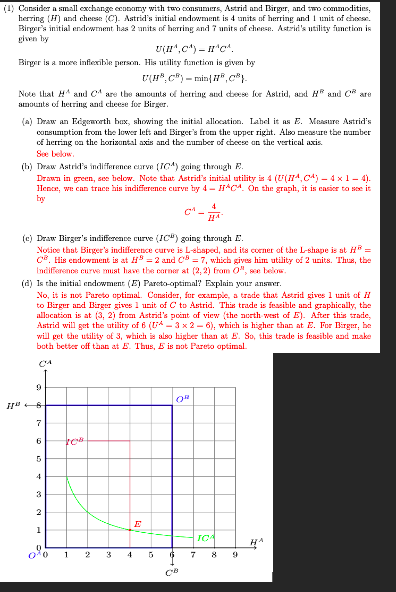(1) Consider a small exchange economy with two consumers, A and B, and two commodities, ₁ and ₂. Consumer A's initial endowment is 3 units of 2₁ and 2 unit of 2. Consumer B's initial endowment has 5 units of 2₁ and 4 units of r2. Consumer A's utility function is given by U(r₁, ₁) = x₁x₁. Consumer B's utility function is given by U(x,x) = 2x³ + x². Note that and are the amounts of the two goods for Consumer A, and rf and are amounts of the two goods for Consumer B. (a) Draw an Edgeworth box, showing the initial allocation. Label it as E. Measure Consumer A's consumption from the lower left and Consumer B's from the upper right. Also measure the number of ₁ on the horizontal axis and the number of r2 on the vertical axis. (b) Draw Consumer A's indifference curve (ICA) going through E. (c) Draw Consumer B's indifference curve (ICB) going through E.
(1) Consider a small exchange economy with two consumers, A and B, and two commodities, ₁ and ₂. Consumer A's initial endowment is 3 units of 2₁ and 2 unit of 2. Consumer B's initial endowment has 5 units of 2₁ and 4 units of r2. Consumer A's utility function is given by U(r₁, ₁) = x₁x₁. Consumer B's utility function is given by U(x,x) = 2x³ + x². Note that and are the amounts of the two goods for Consumer A, and rf and are amounts of the two goods for Consumer B. (a) Draw an Edgeworth box, showing the initial allocation. Label it as E. Measure Consumer A's consumption from the lower left and Consumer B's from the upper right. Also measure the number of ₁ on the horizontal axis and the number of r2 on the vertical axis. (b) Draw Consumer A's indifference curve (ICA) going through E. (c) Draw Consumer B's indifference curve (ICB) going through E.
Chapter13: General Equilibrium And Welfare
Section: Chapter Questions
Problem 13.5P
Related questions
Question
Please help, use second image as reference (different equation)

Transcribed Image Text:(1) Consider a small exchange economy with two consumers, A and B, and two commodities, ₁ and
₂. Consumer A's initial endowment is 3 units of 2₁ and 2 unit of 2. Consumer B's initial
endowment has 5 units of 2₁ and 4 units of r2. Consumer A's utility function is given by
U(r₁, ₁) = x₁x₁.
Consumer B's utility function is given by
U(x,x) = 2x³ + x².
Note that and are the amounts of the two goods for Consumer A, and rf and are
amounts of the two goods for Consumer B.
(a) Draw an Edgeworth box, showing the initial allocation. Label it as E. Measure Consumer A's
consumption from the lower left and Consumer B's from the upper right. Also measure the
number of ₁ on the horizontal axis and the number of x2 on the vertical axis.
(b) Draw Consumer A's indifference curve (ICA) going through E.
(c) Draw Consumer B's indifference curve (ICB) going through E.
(d) Is the initial endowment (E) Pareto-optimal? Explain your answer.
(e) Draw the contract curve in the same Edgeworth box.
9
8
7
6
ان
4
3
2
1
0
012 3 4
5
6
7 8 9

Transcribed Image Text:(1) Consider a small exchange economy with two consumers, Astrid and Birger, and two commodities,
herring (H) and cheese (C). Astrid's initial endowment is 4 units of herring and 1 unit of cheese.
Birger's initial endowment has 2 units of herring and 7 units of cheese. Astrid's utility function is
given by
U(II^,C)-I^C^.
Birger is a more inflexible person. His utility function is given by
U(HC) - min{HⓇ,C³}.
Note that Hand C are the amounts of herring and cheese for Astrid, and HⓇ and Care
amounts of herring and cheese for Birger.
(a) Draw an Edgeworth box, showing the initial allocation. Label it as E. Measure Astrid's
consumption from the lower left and Birger's from the upper right. Also measure the number
of herring on the horizontal axis and the number of cheese on the vertical axis.
See below.
(b) Draw Astrid's indifference curve (ICA) going through E.
Drawn in green, see below. Note that Astrid's initial utility is 4 (U(Hª, CA) – 4 × 1 – 4).
Hence, we can trace his indifference curve by 4- HACA. On the graph, it is easier to see it
by
(e) Draw Birger's indifference curve (IC) going through E.
Notice that Birger's indifference curve is L-shaped, and its corner of the L-shape is at H² =
C. His endowment is at H³ = 2 and C8 = 7, which gives him utility of 2 units. Thus, the
Indifference curve must have the corner at (2, 2) from O", see below.
(d) Is the initial endowment (E) Pareto-optimal? Explain your answer.
No, it is not Pareto optimal. Consider, for example, a trade that Astrid gives 1 unit of H
to Birger and Birger gives 1 unit of C to Astrid. This trade is feasible and graphically, the
allocation is at (3, 2) from Astrid's point of view (the north west of E). After this trade,
Astrid will get the utility of 6 (A-3 x 2-6), which is higher than at E. For Birger, he
will get the utility of 3, which is also higher than at E. So, this trade is feasible and make
both better off than at E. Thus, E is not Pareto optimal.
CA
9
7
6
5
4
3
2
1
you
1
2
3
4
D
5
6
OR
TOA
7
9
Expert Solution
This question has been solved!
Explore an expertly crafted, step-by-step solution for a thorough understanding of key concepts.
This is a popular solution!
Trending now
This is a popular solution!
Step by step
Solved in 5 steps with 5 images

Follow-up Questions
Read through expert solutions to related follow-up questions below.
Knowledge Booster
Learn more about
Need a deep-dive on the concept behind this application? Look no further. Learn more about this topic, economics and related others by exploring similar questions and additional content below.Recommended textbooks for you







